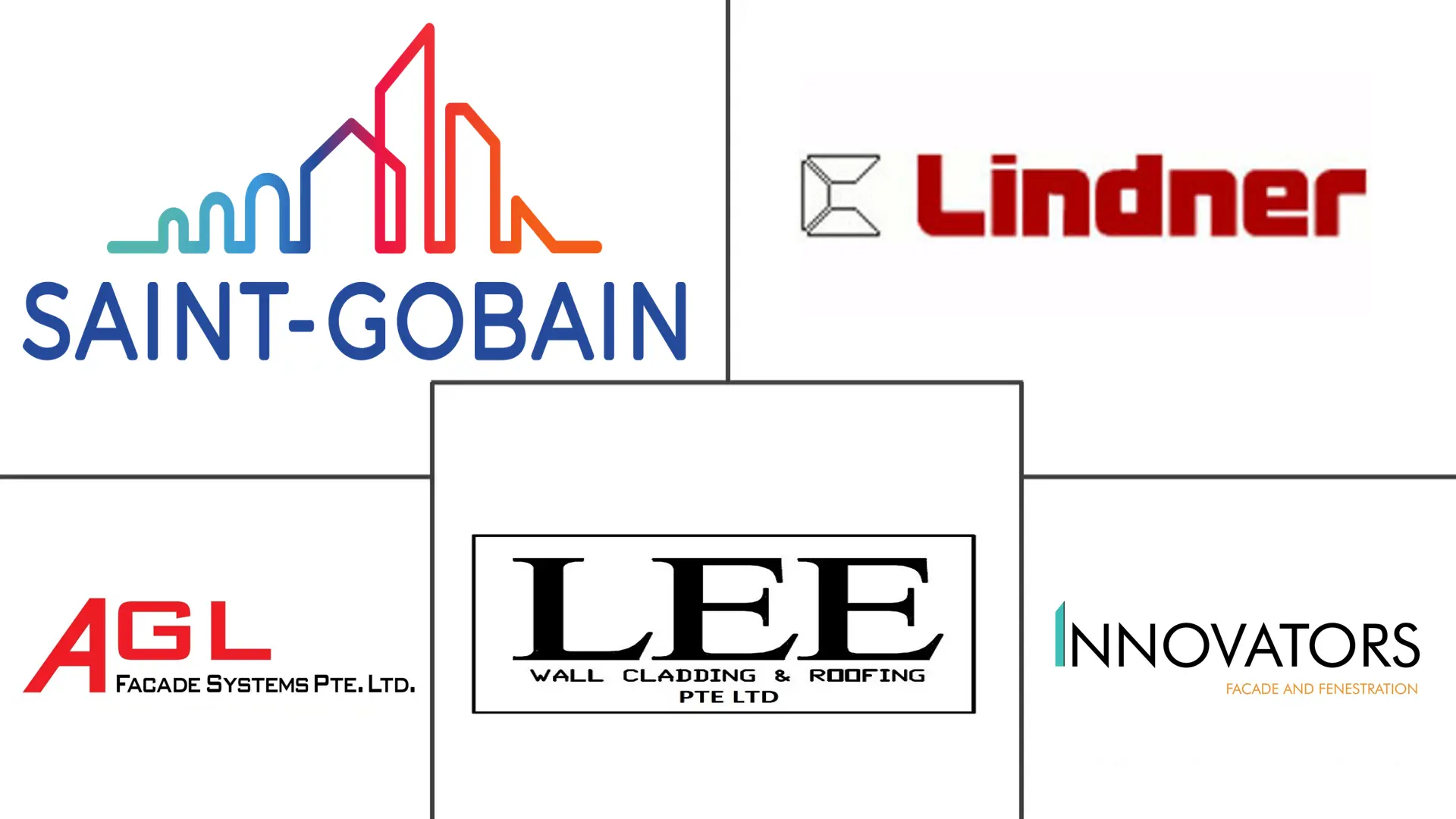Market Size of Asia-Pacific Facade Industry

| Study Period | 2020 - 2029 |
| Base Year For Estimation | 2023 |
| Forecast Data Period | 2024 - 2029 |
| Historical Data Period | 2020 - 2022 |
| CAGR | 6.00 % |
| Market Concentration | Medium |
Major Players
*Disclaimer: Major Players sorted in no particular order |
APAC Facade Market Analysis
The Asia Pacific Façade Market is anticipated to grow at a CAGR of over 6% from 2023 to 2028.
The COVID-19 epidemic continues to significantly negatively impact the global construction sector. A major factor in the Asia Pacific region's economic downturn in 2020-21 was the total lockdown in various cities across important nations including China, India, and Japan. Several ongoing residential, commercial, and industrial building projects have also been forced to stop due to the virus's fast global spread. Therefore, the demand for facade goods and services is anticipated to decline over a shorter period due to the slower development in the building and real estate industries as a result of the reduced demand for purchasing houses and offices. Creating sophisticated materials with characteristics that give safety and aesthetically pleasing texture is expected to fuel robust market expansion during the forecast period. Furthermore, unlike any other construction system, this outer building face combines high performance and aesthetic appeal, predicted to increase demand for the product over the coming years. In the upcoming years, the demand for facades is expected to increase due to the growing desire to reduce heating and cooling expenses and improve energy efficiency. The market is projected to benefit as the development of sustainable products receives more attention. Green construction is becoming more and more popular, and the market's future is likely to be shaped by the rising need for very transparent glasses that pass light while being heat resistant. High-performance and energy-efficient solar control facades are anticipated to be used in the market, resulting in increased economic advantages and environmental sustainability. Furthermore, it is predicted that during the next seven years, the industry will rise due to government efforts and regulations, technical improvements, and the demand for energy conservation.
APAC Facade Industry Segmentation
The consumer intelligence and competitive analysis of the Asia Pacific Façade Market is the focus of the region research report on the façade market in the Asia Pacific Region. The study also offers in-depth insights into market trends, demand predictions, and micro and macro indicators in the Asia Pacific market. The paper also discusses the market dynamics influencing and constraining the façade market. This comprehensive business intelligence report is based on the market's qualitative and quantitative metrics. This research also offers readers market insights and a thorough examination of market categories down to potential micro levels. Manufacturers and suppliers for the Asia Pacific Façade Market are among the companies and dealers/distributors mentioned in the study.
The Asia Pacific Facade Market is segmented By Material (Glass, Wool, Aluminium, Others), By Product (Ventilated, Non-Ventilated), By End User(Residential, Commercial, Industrial), and By Region(China, Japan, India, Rest of Asia Pacific). The report offers size and forecasts for the Asia Pacific Facade Market in value (USD billion) for all the above segments. The impact of the COVID-19 pandemic is also covered in the report.
Asia-Pacific Facade Market Size Summary
The Asia-Pacific facade market is poised for significant growth, driven by urbanization, modernization, and a shift in consumer preferences towards energy-efficient and aesthetically pleasing building exteriors. The market is recovering from the setbacks caused by the COVID-19 pandemic, which had a pronounced impact on the construction sector due to lockdowns in major economies like China, India, and Japan. As the region rebounds, the demand for facades is expected to rise, fueled by the increasing focus on reducing energy costs and enhancing energy efficiency. The trend towards green construction and sustainable products is gaining momentum, with high-performance solar control facades becoming more prevalent. This shift is supported by government initiatives, technological advancements, and a growing emphasis on energy conservation, which are all contributing to the market's expansion.
In India, the facade market is experiencing robust growth due to increased urbanization, rising disposable incomes, and government-funded housing schemes. The popularity of durable and eco-friendly materials, such as polycarbonate and corrugated facades, is further propelling market expansion. The market is characterized by a mix of international, regional, and local players, with companies like AGL Façade Systems Pte. Ltd., Leo Fab Asia, and Lindner Group KG playing pivotal roles. These companies are leveraging strategies such as new product launches, mergers and acquisitions, and partnerships to maintain competitiveness. The introduction of innovative materials and technologies, such as phase change materials and bioplastics, is expected to drive future growth, particularly in the residential, industrial, and large-scale commercial sectors.
Asia-Pacific Facade Market Size - Table of Contents
-
1. 4.MARKET INSIGHTS & DYNAMICS
-
1.1 Current Market Scenario
-
1.2 Market Dynamics
-
1.2.1 Market Drivers
-
1.2.2 Restraints
-
1.2.3 Opportunities
-
-
1.3 Industry Attractiveness - Porter's Five Forces Analysis
-
1.4 Value Chain/Supply Chain Analysis
-
1.5 Recent Trends and Developments
-
1.6 Impact of COVID-19 on the Market
-
-
2. 5 MARKET SEGMENTATION
-
2.1 By Material
-
2.1.1 Glass
-
2.1.2 Wool
-
2.1.3 Aluminium
-
2.1.4 Others
-
-
2.2 By Product
-
2.2.1 Ventilated
-
2.2.2 Non-Ventilated
-
-
2.3 By End User
-
2.3.1 Residential
-
2.3.2 Commercial
-
2.3.3 Industrial
-
-
2.4 By Region
-
2.4.1 China
-
2.4.2 Japan
-
2.4.3 India
-
2.4.4 Rest of Asia-Pacific
-
-
Asia-Pacific Facade Market Size FAQs
What is the current Asia-Pacific Facade Market size?
The Asia-Pacific Facade Market is projected to register a CAGR of greater than 6% during the forecast period (2024-2029)
Who are the key players in Asia-Pacific Facade Market?
https://www.lindner-group.com/en/, https://www.leofabasia.com/contact-us.html, https://leewallcladding.com/index.html, https://agl.com.sg/, https://www.aluvisionfs.in/, https://www.saint-gobain.co.in/ and https://innovators.in/ are the major companies operating in the Asia-Pacific Facade Market.

